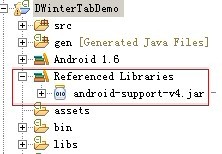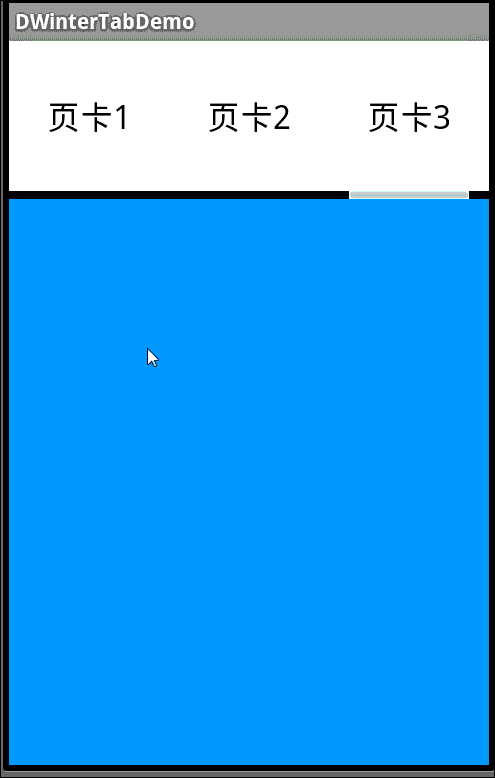
- Android中调用系统的文件浏览器及自制简单的文件浏览器
- Android获取窗体信息的Util方法
- Android Retrofit 2.0框架上传图片解决方案
- Android编程实现获取图片资源的四种方法
- android 中去掉窗口全屏显示的简单方法
- logcat命令使用方法和查看android系统日志缓冲区内容的方法
- Android中创建对话框(确定取消对话框、单选对话框、多选对话框)实例代码
- Android实用的代码片段 常用代码总结
- android 分辨率适配的方法
- Android编程常用技巧实例总结
- Android编程操作嵌入式关系型SQLite数据库实例详解
- Android Activity与Intent详解及示例代码
- Android实现在屏幕上移动图片的方法
- Java4Android开发教程(三)java基本概念
- Android实现横向二级菜单
- 详解Android开发中Activity的四种launchMode
- Android实现悬浮对话框代码
- Android巧用ActionBar实现tab导航效果
- myeclipse android环境搭建图文教程
- Android实现GridView中ImageView动态变换的方法
- Android实现从本地图库/相机拍照后裁剪图片并设置头像
- android 自定义控件 自定义属性详细介绍
- Android百度地图poi范围搜索
- Android中Activity常用功能设置小结(包括全屏、横竖屏等)
- android使用handler ui线程和子线程通讯更新ui示例
- Android性能优化以及数据优化方法
- android将搜索引擎设置为中国雅虎无法搜索问题解决方法
- android滑动解锁震动效果的开启和取消
- Android调用默认浏览器打开指定Url的方法实例
- Android中 webView调用JS出错的解决办法
Android编程实现ViewPager多页面滑动切换及动画效果的方法
作者:佚名 Android开发编辑:admin 更新时间:2022-07-23
本文实例讲述了Android编程实现ViewPager多页面滑动切换及动画效果的方法。分享给大家供大家参考,具体如下:
一、首先,我们来看一下效果图,这是新浪微博的Tab滑动效果。我们可以手势滑动,也可以点击上面的头标进行切换。与此同方式,
白色横条会移动到相应的页卡头标下。这是一个动画效果,白条是缓慢滑动过去的。好了,接下来我们就来实现它。

二、在开始前,我们先要认识一个控件,ViewPager。它是google SDk中自带的一个附加包的一个类,可以用来实现屏幕间的切换。
这个附加包是android-support-v4.jar,在最后的源码中会提供给大家,在libs文件夹中。当然你也可以自己从网上搜索最新的版本。
找到它后,我们需要在项目中添加

三、我们先做界面
界面设计很简单,第一行三个头标,第二行动画图片,第三行页卡内容展示。
<?xml version="1.0" encoding="utf-8"?> <LinearLayout xmlns:android="http://schemas.android.com/apk/res/android" xmlns:umadsdk="http://schemas.android.com/apk/res/com.LoveBus" android:layout_width="fill_parent" android:layout_height="fill_parent" android:orientation="vertical" > <LinearLayout android:id="@+id/linearLayout1" android:layout_width="fill_parent" android:layout_height="100.0dip" android:background="#FFFFFF" > <TextView android:id="@+id/text1" android:layout_width="fill_parent" android:layout_height="fill_parent" android:layout_weight="1.0" android:gravity="center" android:text="页卡1" android:textColor="#000000" android:textSize="22.0dip" /> <TextView android:id="@+id/text2" android:layout_width="fill_parent" android:layout_height="fill_parent" android:layout_weight="1.0" android:gravity="center" android:text="页卡2" android:textColor="#000000" android:textSize="22.0dip" /> <TextView android:id="@+id/text3" android:layout_width="fill_parent" android:layout_height="fill_parent" android:layout_weight="1.0" android:gravity="center" android:text="页卡3" android:textColor="#000000" android:textSize="22.0dip" /> </LinearLayout> <ImageView android:id="@+id/cursor" android:layout_width="fill_parent" android:layout_height="wrap_content" android:scaleType="matrix" android:src="@drawable/a" /> <android.support.v4.view.ViewPager android:id="@+id/vPager" android:layout_width="wrap_content" android:layout_height="wrap_content" android:layout_gravity="center" android:layout_weight="1.0" android:background="#000000" android:flipInterval="30" android:persistentDrawingCache="animation" /> </LinearLayout>
我们要展示三个页卡,所以还需要三个页卡内容的界面设计,这里我们只设置了背景颜色,能起到区别作用即可。
<?xml version="1.0" encoding="utf-8"?> <LinearLayout xmlns:android="http://schemas.android.com/apk/res/android" android:layout_width="fill_parent" android:layout_height="fill_parent" android:orientation="vertical" android:background="#158684" > </LinearLayout>
四、代码部分要进行初始化的工作
(1) 先来变量的定义
private ViewPager mPager;//页卡内容 private List<View> listViews; // Tab页面列表 private ImageView cursor;// 动画图片 private TextView t1, t2, t3;// 页卡头标 private int offset = 0;// 动画图片偏移量 private int currIndex = 0;// 当前页卡编号 private int bmpW;// 动画图片宽度
(2) 初始化头标
/**
* 初始化头标
*/
private void InitTextView() {
t1 = (TextView) findViewById(R.id.text1);
t2 = (TextView) findViewById(R.id.text2);
t3 = (TextView) findViewById(R.id.text3);
t1.setOnClickListener(new MyOnClickListener(0));
t2.setOnClickListener(new MyOnClickListener(1));
t3.setOnClickListener(new MyOnClickListener(2));
}
/**
* 头标点击监听
*/
public class MyOnClickListener implements View.OnClickListener {
private int index = 0;
public MyOnClickListener(int i) {
index = i;
}
@Override
public void onClick(View v) {
mPager.setCurrentItem(index);
}
};
相信大家看后都没什么问题,点击第几个,就展示第几个页卡内容。
(3) 初始化页卡内容区
/**
* 初始化ViewPager
*/
private void InitViewPager() {
mPager = (ViewPager) findViewById(R.id.vPager);
listViews = new ArrayList<View>();
LayoutInflater mInflater = getLayoutInflater();
listViews.add(mInflater.inflate(R.layout.lay1, null));
listViews.add(mInflater.inflate(R.layout.lay2, null));
listViews.add(mInflater.inflate(R.layout.lay3, null));
mPager.setAdapter(new MyPagerAdapter(listViews));
mPager.setCurrentItem(0);
mPager.setOnPageChangeListener(new MyOnPageChangeListener());
}
我们将三个页卡界面装入其中,默认显示第一个页卡。这里我们还需要实现一个适配器。
/**
* ViewPager适配器
*/
public class MyPagerAdapter extends PagerAdapter {
public List<View> mListViews;
public MyPagerAdapter(List<View> mListViews) {
this.mListViews = mListViews;
}
@Override
public void destroyItem(View arg0, int arg1, Object arg2) {
((ViewPager) arg0).removeView(mListViews.get(arg1));
}
@Override
public void finishUpdate(View arg0) {
}
@Override
public int getCount() {
return mListViews.size();
}
@Override
public Object instantiateItem(View arg0, int arg1) {
((ViewPager) arg0).addView(mListViews.get(arg1), 0);
return mListViews.get(arg1);
}
@Override
public boolean isViewFromObject(View arg0, Object arg1) {
return arg0 == (arg1);
}
@Override
public void restoreState(Parcelable arg0, ClassLoader arg1) {
}
@Override
public Parcelable saveState() {
return null;
}
@Override
public void startUpdate(View arg0) {
}
}
这里我们实现了各页卡的装入和卸载
(3) 初始化动画
/**
* 初始化动画
*/
private void InitImageView() {
cursor = (ImageView) findViewById(R.id.cursor);
bmpW = BitmapFactory.decodeResource(getResources(), R.drawable.a)
.getWidth();// 获取图片宽度
DisplayMetrics dm = new DisplayMetrics();
getWindowManager().getDefaultDisplay().getMetrics(dm);
int screenW = dm.widthPixels;// 获取分辨率宽度
offset = (screenW / 3 - bmpW) / 2;// 计算偏移量
Matrix matrix = new Matrix();
matrix.postTranslate(offset, 0);
cursor.setImageMatrix(matrix);// 设置动画初始位置
}
根据屏幕的分辨率和图片的宽度计算动画移动的偏移量

实现页卡切换监听
/**
* 页卡切换监听
*/
public class MyOnPageChangeListener implements OnPageChangeListener {
int one = offset * 2 + bmpW;// 页卡1 -> 页卡2 偏移量
int two = one * 2;// 页卡1 -> 页卡3 偏移量
@Override
public void onPageSelected(int arg0) {
Animation animation = null;
switch (arg0) {
case 0:
if (currIndex == 1) {
animation = new TranslateAnimation(one, 0, 0, 0);
} else if (currIndex == 2) {
animation = new TranslateAnimation(two, 0, 0, 0);
}
break;
case 1:
if (currIndex == 0) {
animation = new TranslateAnimation(offset, one, 0, 0);
} else if (currIndex == 2) {
animation = new TranslateAnimation(two, one, 0, 0);
}
break;
case 2:
if (currIndex == 0) {
animation = new TranslateAnimation(offset, two, 0, 0);
} else if (currIndex == 1) {
animation = new TranslateAnimation(one, two, 0, 0);
}
break;
}
currIndex = arg0;
animation.setFillAfter(true);// True:图片停在动画结束位置
animation.setDuration(300);
cursor.startAnimation(animation);
}
@Override
public void onPageScrolled(int arg0, float arg1, int arg2) {
}
@Override
public void onPageScrollStateChanged(int arg0) {
}
}
五、打完收工,快来看看自己的劳动成果吧

希望本文所述对大家Android程序设计有所帮助。
- 上一篇文章: Android编程实现图片的浏览、缩放、拖动和自动居中效果
- 下一篇文章: Android编程实现获取新浪天气预报数据的方法
- android中可以通过两种方式调用接口发送短信
- Android开发艺术探索学习笔记(七)
- Android实现手势滑动多点触摸缩放平移图片效
- Android获取当前位置的经纬度数据
- Android中Handler消息传递机制
- 浅析Android手机卫士手机定位的原理
- Android中制作自定义dialog对话框的实例分享